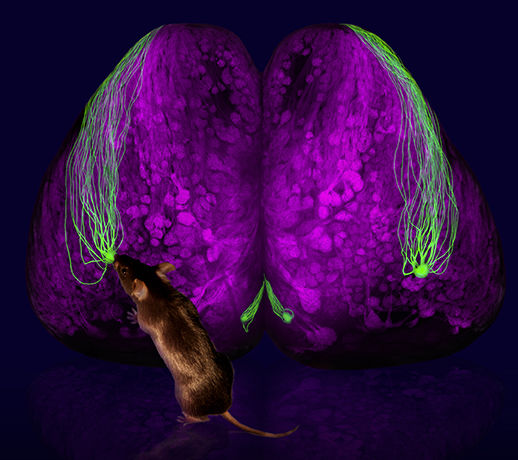
We are using wide-field and two-photon imaging, multiunit electrophysiology and behavioral experiments, in combination with theoretical approaches, to study how odors are represented at different stages of neural processing. To understand how spatiotemporal neural codes are read by the brain and evoke behavior, we are developing optogenetic pattern stimulation techniques, including 2P holography. Most of the projects are deeply rooted in theoretical approaches and statistical modeling. In addition, as an applied direction, we are developing bio-electronic nose, a universal, versatile, and sensitive chemical detector based on the mouse olfactory system.
Basic principles of the olfactory coding
Understanding sensory processing relies on exploring and
establishing a principled relationship between the stimulus space,
its neural representation, and perceptual quality. We tackle this
challenge using an interdisciplinary approach that combines
experimental, computational and theoretical tools.
In our experiments, we interrogate the olfactory system of behaving mice at different levels using rapid wide-field and two-photon imaging, multi-unit electrophysiology, optogenetic pattern stimulation, and quantitative behaviors.
Based on the recently proposed primacy model for concentration invariant
odor coding(Wilson-2017) and a few simplifying assumptions, we have
developed a theoretical framework for mapping the odor input space to
the response properties of olfactory receptors (Giaffar-2017). The theory predicts specific relationships between receptors fields of individual
receptor types (or glomeruli), the statistical features of mitral/tufted cell
feedforward connectivity to the cortex, processing of odor mixtures, and
structure of perceptual odor space.
Currently we are developing both experimental and computational
approaches to verify assumptions and test predictions of the theory.
This work is highly collaborative and we also lead the
BRAIN Initiative consortium "Cracking the Olfactory Code".

Odor identities are defined by the sets of primary (the most sensitive) receptors {1,2,3} and {3,4,5}, which are represented as simplexes on the low dimensional manifold in the
space of the receptor affinities
to different ligands.
Odor evoked glomerular activity imaged with gcamp6f expressed in axon terminals of olfactory sensory neuron

Behavioral relevance of neuronal code features
The most powerful way to test a neural coding model is to validate that the hypothesized code can be read by higher brain areas where it leads to an observable behavioral output. To this end, we are developing experimental strategies to establish causal links between the neuronal code and animal behavior. Following our earlier work with single glomerulus stimulation (Smear-2013) we are developing a general approach to test the readability of the olfactory code using an optogenetic pattern stimulation system in behaving mice. In this paradigm, mice are trained to recognize a specific spatial-temporal pattern of glomerulus activation. Through systematic perturbation of this pattern during measurements of the behavioral response to these perturbations, we investigate the role of different features of the code for animal behavior (Chong-2020)
The next step after dissecting the olfactory code a the glomerulus/receptor
level is testing of neural coding models at the individual neuron level. This requires developing a different
technology capableof individual neuron stimulation. In a collaborative project with the Shoham lab (Tech4Health, NYU), we are developing a system for 2-photon holographic optogenetic stimulation of multiple neurons deep in the brain of the behaving animal (Gill-2020).
Bio-electronic nose
We are developing a universal, versatile, and sensitive chemical detector based on the mouse olfactory system. For years, trained animals were used for chemical detection in homeland security, defense, healthcare, agriculture, and other applications, because a biological olfactory system outperform all artificial chemical detection devices, especially when it comes to simultaneous versatility, speed, and specificity in detecting volatile chemicals.

However, the use of animals in this capacity requires extensive training and behavior-based communication. Here we are developing an alternative strategy, that bypasses behavioral output by reading olfactory information directly from the brain. We use brain-machine interface that capture signals from an early stage of olfactory processing in mice, and machine learning techniques to form a sensitive and selective chemical detector.
As a proof of concept, we have demonstrated that the system is capable of detection odors at concentrations comparable to that achieved by a trained animal. It can classify multiple odorants and concentrations. Current efforts are focused in developing the system towards detection and classification of real-world targets to investigate whether it can be used, for example, to find explosives or diagnose diseases (Shor-2020).